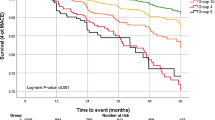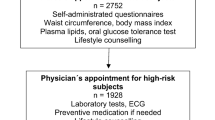Abstract
Background
Diabetes mellitus (DM) is associated with increased risk of embolic complications in non-valvular atrial fibrillation (NVAF). Impaired renal function (IRF) increases the risk of stroke as well, but this finding is not consistent among all studies. Our aim was to assess the incidence rates and risk of ischemic stroke and mortality by baseline Estimated Glomerular Filtration Rate (eGFR) levels Among individuals with AF and DM.
Methods
A prospective, historical cohort study using the Clalit Health Services electronic medical records database. Among patients with AF and DM, we compared three groups according to eGFR levels: eGFR ≥ 60, between 30 and 60, and ≤ 30 (mL/min/1.73m2).
Results
A total of 17,567 cases were included in the final analysis; of them, 11,013 (62.7%) had eGFR ≥ 60, 4930 (28%) had eGFR between 30 and 60, and 1624 (9.24%) with eGFR ≤ 30. The incidence of stroke per 100 person-years in the three study groups was: 1.88, 2.69, and 3.34, respectively (p < 0.001). IRF was associated with increased risk of stroke in univariate analysis, but not after multivariate adjustment (Adjusted Hazard Ratio (AHR) 0.96 {95%CI; 0.74–1.25} for eGFR 30–60 and 0.96 {95%CI; 0.60–1.55} for eGFR ≤ 30). Mortality per 100 person-years was 10.78, 21.49, and 41.55, respectively (p < 0.001). IRF was associated with increased mortality risk in univariate analysis, as well as in multivariate analysis (AHR 1.08 {95%CI; 0.98–1.18} for eGFR 30–60, and 1.59 {95%CI; 1.37–1.85} for eGFR ≤ 30.
Conclusion
In patients with NVAF and DM, IRF was not associated with an increased risk of stroke, but severe IRF (eGFR ≤ 30) was associated with increased mortality risk.


Similar content being viewed by others
References
Wang TJ et al (2003) A risk score for Predicting Stroke or Death in individuals with New-Onset Atrial Fibrillation in the community: the Framingham Heart Study. J Am Med Assoc 290:1049–1056
Hart RG et al (2007) Independent predictors of Stroke in patients with atrial fibrillation: a systematic review. Neurology 69:546–554
Gage BF et al (2001) Validation of clinical classification schemes for predicting Stroke: results from the National Registry of Atrial Fibrillation. J Am Med Assoc 285:2864–2870
Lip GYH et al (2010) Refining clinical risk stratification for predicting Stroke and thromboembolism in atrial fibrillation using a novel risk factor-based approach: the Euro Heart Survey on atrial fibrillation. Chest 137:263–272
Kirchhof P et al (2016) 2016 ESC Guidelines for the management of atrial fibrillation developed in collaboration with EACTS. European Heart Journal vol. 37 Preprint at https://doi.org/10.1093/eurheartj/ehw210
January CT, AHA/ACC/HRS Focused Update of the 2014 AHA/ACC/HRS Guideline for the Management of Patients With Atrial Fibrillation (2019) : A Report of the American College of Cardiology/American Heart Association Task Force on Clinical Practice Guidelines and the Heart Rhythm Society in Collaboration With the Society of Thoracic Surgeons. Circulation vol. 140 e125–e151 Preprint at https://doi.org/10.1161/CIR.0000000000000665 (2019)
Piccini JP et al (2013) Renal dysfunction as a predictor of Stroke and systemic Embolism in patients with nonvalvular atrial fibrillation: validation of the R2CHADS2 index in the ROCKET AF. Circulation 127:224–232
Singer DE et al (2013) A new risk scheme to predict ischemic Stroke and other thromboembolism in atrial fibrillation: the ATRIA study Stroke risk score. J Am Heart Assoc. https://doi.org/10.1161/JAHA.113.000250
Olesen JB et al (2012) Stroke and bleeding in Atrial Fibrillation with chronic Kidney Disease. N Engl J Med 367:625–635
Go AS et al (2009) Impact of proteinuria and glomerular filtration rate on risk of thromboembolism in atrial fibrillation: the anticoagulation and risk factors in atrial fibrillation (ATRIA) study. Circulation 119:1363–1369
Nakayama M et al (2007) Kidney dysfunction as a risk factor for first symptomatic Stroke events in a general Japanese population - the Ohasama study. Nephrol Dialysis Transplantation 22:1910–1915
Hart RG, Pearce LA, Asinger RW, Herzog CA (2011) Warfarin in atrial fibrillation patients with moderate chronic Kidney Disease. Clin J Am Soc Nephrol 6:2599–2604
Zeng WT et al (2015) Risk of thromboembolic events in atrial fibrillation with chronic Kidney Disease. Stroke. https://doi.org/10.1161/STROKEAHA.114.006881
Friberg L, Benson L, Lip GYH (2015) Balancing Stroke and bleeding risks in patients with atrial fibrillation and Renal Failure: the Swedish Atrial Fibrillation Cohort study. Eur Heart J 36:297–306
Banerjee A et al (2013) Renal impairment and ischemic Stroke risk assessment in patients with atrial fibrillation: the Loire valley atrial fibrillation project. J Am Coll Cardiol. https://doi.org/10.1016/j.jacc.2013.02.035
Reges O et al (2020) Combining inpatient and outpatient data for diagnosis of non-valvular atrial fibrillation using electronic health records: a validation study. Clin Epidemiol 12:477–483
Karpati T et al (2014) Towards a subsiding Diabetes epidemic: Trends from a large population-based study in Israel. Popul Health Metr. https://doi.org/10.1186/s12963-014-0032-y
Schold JD et al (2011) Implications of the CKD-EPI GFR estimation equation in clinical practice. Clin J Am Soc Nephrol 6:497–504
Austin PC, Fine JP (2017) Practical recommendations for reporting Fine-Gray model analyses for competing risk data. Stat Med 36:4391–4400
Anderson JL et al (2013) Management of patients with atrial fibrillation (compilation of 2006 accf/aha/esc and 2011 accf/aha/hrs recommendations): a report of the American college of cardiology/american heart association task force on practice guidelines. Circulation 127:1916–1926
Potpara TS, Ferro CJ, Lip GYH (2018) Use of oral anticoagulants in patients with atrial fibrillation and renal dysfunction. Nat Rev Nephrol 14:337–351
Lemkes BA et al (2010) Hyperglycemia: a prothrombotic factor? J Thromb Haemostasis Preprint at. https://doi.org/10.1111/j.1538-7836.2010.03910.x
Keller C, Katz R, Cushman M, Fried LF, Shlipak M (2008) Association of kidney function with inflammatory and procoagulant markers in a diverse cohort: a cross-sectional analysis from the multi-ethnic study of Atherosclerosis (MESA). BMC Nephrol 9,
Grant PJ (2007) Diabetes Mellitus as a prothrombotic condition. J Intern Med 262:157–172
Molino D, De Lucia D, De Santo NG (2006) Coagulation disorders in uremia. Semin Nephrol. https://doi.org/10.1016/j.semnephrol.2005.06.011
Carr ME (2001) Diabetes Mellitus: a hypercoagulable state. J Diabetes Complications 15:44–54
Jalal DI, Chonchol M, Targher G (2010) Disorders of hemostasis associated with chronic kidney disease. Seminars in Thrombosis and Hemostasis vol. 36 34–40 Preprint at https://doi.org/10.1055/s-0030-1248722
Pretorius E (2017) Mechanisms of Hypercoagulation and Aberrant Clot Lyses in Type 2 Diabetes. in Mechanisms of Vascular Defects in Diabetes Mellitus 377–393 https://doi.org/10.1007/978-3-319-60324-7_17
Kuno T et al (2020) Oral anticoagulation for patients with Atrial Fibrillation on Long-Term Hemodialysis. J Am Coll Cardiol 75:273–285
Randhawa MS et al (2020) Association between Use of Warfarin for Atrial Fibrillation and outcomes among patients with end-stage renal Disease: a systematic review and Meta-analysis. JAMA Netw Open 3, e202175
Bansal N, Fan D, Hsu C, yuan, Ordonez JD, Go AS (2014) Incident atrial fibrillation and risk of death in adults with chronic Kidney Disease. J Am Heart Assoc 3,
HS H et al (2014) Clinical significance of chronic Kidney Disease and atrial fibrillation on morbidity and mortality in patients with acute Myocardial Infarction. Am J Nephrol 40:345–352
Lau YC, Proietti M, Guiducci E, Blann AD, Lip GYH (2016) Atrial fibrillation and thromboembolism in patients with chronic Kidney Disease. J Am Coll Cardiol 68:1452–1464
Funding
The authors are employees of Clalit Health Services and Clalit Health Services Research Institute. The current study is investigator-initiated and funded by Pfizer Inc via the BMS/Pfizer European Thrombosis Investigator Initiated Research Program (ERISTA).
Author information
Authors and Affiliations
Corresponding author
Additional information
Publisher’s Note
Springer Nature remains neutral with regard to jurisdictional claims in published maps and institutional affiliations.
Electronic supplementary material
Below is the link to the electronic supplementary material.
Rights and permissions
Springer Nature or its licensor (e.g. a society or other partner) holds exclusive rights to this article under a publishing agreement with the author(s) or other rightsholder(s); author self-archiving of the accepted manuscript version of this article is solely governed by the terms of such publishing agreement and applicable law.
About this article
Cite this article
Westreich, R., Tsaban, G., Barrett, O. et al. Estimated glomerular filtration rate and the risk of stroke in individuals with diabetes mellitus and atrial fibrillation insight from a large contemporary population study. J Thromb Thrombolysis 57, 322–329 (2024). https://doi.org/10.1007/s11239-023-02913-8
Accepted:
Published:
Issue Date:
DOI: https://doi.org/10.1007/s11239-023-02913-8




